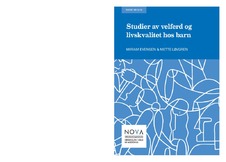| dc.description.abstract | The welfare and wellbeing of children and youth is subject to political as well as scholarly attention. In this report, we present the most central quantitative contributions, both national and international ones, to the field. We also present measures used to map welfare and wellbeing in the lives of children. This summary of the field is part of NOVA’s work with municipal youth-surveys, as these surveys are being expanded to include younger respondents. Until now, those surveyed have been between the ages of 13-19. In the future, the age span will include 10-12 year olds. We know far less of this younger group than we do of those that are older, and this report serves as a backdrop for the work of NOVA in regard to this age group. The age span 10-12 years is marked by change, both in the social organizing of which the children are part as well as developmentally. The social space of the children expand, they increasingly orient themselves towards their peers and embark on personal identity formation. Developmentally, children go through cognitive as well as biological changes. While so-called objective measures capture some aspects of these changes, subjective measures are necessary to grasp the experiences and perspectives of the children themselves. Until recently, studies investigating the welfare and wellbeing of children in this age group have relied upon objective measures. Objective measures have been used widely, both nationally and internationally. Examples of such measures are vaccination rate or infant mortality. Parents or caregivers have also been sources of information about the welfare and wellbeing of children. However, subjective measures are used increasingly and children themselves are invited to participate. This change is due to more emphasis being put upon the right of children to voice their opinion, as well as welfare and wellbeing in the present - rather than e.g. as predictors of future wellbeing – receiving more attention. These studies stem from a long tradition of mapping welfare in populations, with the intent of promoting health and measure societal development along multiple dimensions. Welfare studies have a long tradition in Norway, but studies aimed directly at youth are more recent – from the 90ies and forward, and mostly with youths rather than children as participants. Even though many studies have used objective measures, some have been conducted in which children participated and subjective measures were used – national as well as international studies. Wellbeing is operationalized differrently across studies, but most definitions include material, physical, cognitive as well as emotional dimensions. Wellbeing is also being measured in different domains, such as school, parents, friends, etc. In this report, we describe some frequently measured domains, in which both objective and subjective measures are being used. These measures are e.g. health, resources, education and relations to others. Findings from studies using subjective measures demonstrate that children in very different countries still evaluate their lives and themselves similarly. For instance, most children report good life quality, and to be satisfied at home and at school. Some gender differences persist across countries, for instance are girls more often dissatisfied with how they look and more often than boys report of health problems. Another finding is that wellbeing vary among children with different socio-economic backgrounds, and that younger children more often than older children report of being bullied. A cause for concern is the raise – especially among girls – in reports of mental health problems. The most important contribution of this report is its account of the differences in understandings of wellbeing among children, and objective measures versus subjective measures. We demonstrate the value of using subjective measures and inviting children as participants, and a multi-dimensional understanding of wellbeing. To collect data on the experiences, feelings and viewpoints of children is important in order to know more about their wellbeing in the present, to inform and evaluate policies aimed at improving their living conditions as well as for providing valuable material for expanding the body of childhood research. | en |
| dc.description.abstract | Studier av velferd og livskvalitet hos barn har en relativ kort historie. Studier som undersøker livskvalitet og velferd har dels sitt utspring i en helsefremmende tradisjon og dels i en samfunnsviten-skapelig tradisjon, der målet har vært å måle samfunnsutvikling langs flere dimensjoner. Barns velferd og livskvalitet har vært målt lenge, men hovedsakelig ved såkalte objektive mål. Samtidig med at barns rett til å ytre sin mening har blitt tillagt større vekt, har det blitt et økt fokus på velferd i barneårene. Resultatet av disse endringene er en fremvekst av studier som benytter subjektive mål, der barn selv deltar. Funn fra slike studier viser at barns livskvalitet generelt er god, men at det også blant barn er økt rapportering av psykiske plager. | no_NB |
